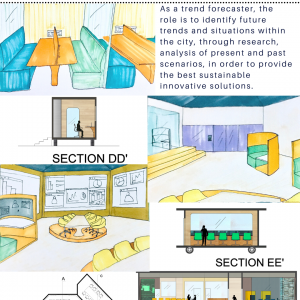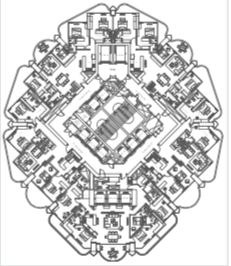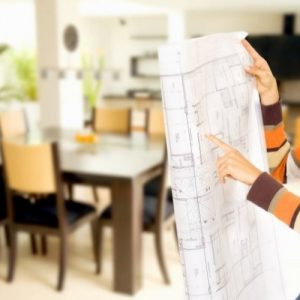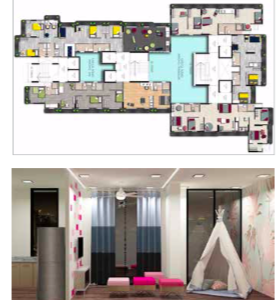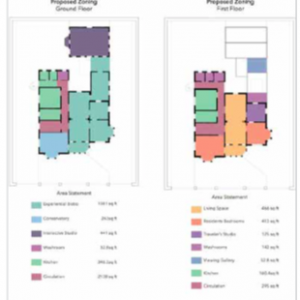Sustainable Interior Design Guide
Did you know that the interior design of your home can have a detrimental impact on the environment?
One-third of the world’s total waste and around 40% of global carbon dioxide emissions come from the construction industry, in which interior design is very much included.
If you are someone who has finally come under the influence of the “sustainability” buzzword and are looking for green interior designing options in hopes of doing a favor to the environment, then look no further, as this sustainable interior design guide is just for you!
What is Sustainable Design?

In simple words, green interior designing involves designing homes in such a way that it makes them eco-friendly, minimizes waste, and is energy efficient. The main aim is to provide healthy, sustainable environments for people of all ages to work, live, and play in.
The best part is that sustainable interiors are gaining more and more popularity every day, making them super accessible so that more people can make a positive impact on the environment.
If you believe in making a difference then you’ll need to be ready with your tools, so let’s get you brushed up on that!
Sustainable materials for interior design and green home solutions
Now that you know why it is important to look at sustainable alternatives for interior design, we can move on to the next segment of this guide: what materials, exactly, can you use for green interior designing?

9 materials you can use for sustainable designing:
-
Reclaimed Wood
Reclaimed wood is nothing more than wood made from old, recycled material.
- It can be used to make coffee tables, rocking chairs, and flooring.
-
Bamboo
It’s quite amazing how fast bamboo can grow – about 1.5 inches per hour! This makes bamboo a renewable alternative to other types of wood.
- Bamboo can be grown in various topographies and hardly requires fertilizers or pesticides.
- Thus, from an ecological standpoint, using bamboo over the more commonly used types of woods is a much more sustainable option.
-
Recycled Metal
Everyone has studied in school about how recycling is beneficial for the environment. Recycling in interior design is no exception!
- Recycling metal requires less processing as well as fewer resources.
- Such furniture proves to be a greener alternative to those made with non-renewable materials.
- Recycled metal can give furniture such as aluminum chairs a smart, modern look.
-
Recycled Plastic
Who knew that plastic, the most infamous non-biodegradable material, can be used to furnish homes of all things?
- Recycled plastic can be used to make indoor and outdoor rugs.
-
Jute Fibers
Every Indian household has had at least a few jute bags. Well, now they can also be used in interior design!
- Jute is a good insulator of heat, making it a sustainable material to be used to make rugs.
- Jute is not only eco-friendly but also radiates an earthy tone and is highly economical.
-
Bio-glass
Bio-glass is used a lot for eco-friendly interior designs because it is a low environmental impact solution. It’s famous for its non-reactive properties and glossy aesthetic.
Did you know?
Glass can have a recycling rate of up to 80%!
- Recycled glass can be used to make décor items, countertops, bathroom sinks, and flooring to give the home a chic and classy look.
-
Non-toxic paint
It may come as a shock to you when I tell you that the air you inhale indoors can be as much as three times more polluted than outdoor air.
The paints generally used in homes today are, firstly, extremely energy-intensive to manufacture. And secondly, they are made up of chemicals that emit harmful compounds even several years after your home has been painted. Fret not and breathe easy, for a solution does exist!
- One can easily find paints made of natural raw ingredients with negligible amounts of volatile organic compounds (VOCs).
- These green alternatives to toxic paints do not come at the sacrifice of quality and are readily available in today’s market.
-
Cork
Don’t be fooled by their initial spongy feel – cork floors are made such that they feel like hardwood.
- These floors are a green alternative because the extraction of cork is done by harvesting the bark of trees, and the actual trees remain unharmed.
-
Sustainable Lighting
I’m sure we can all agree that a home’s aesthetics depend upon not just its interior décor and art, but also its lighting. Well, we’re here to tell you that this important aspect can be sustainable too!
- LED light bulbs are highly energy-efficient. The best part is that just because you’re switching over to LED does not mean that you will have to give up on your beautiful chandeliers, lanterns, or lamps – the source of light does not have to change!
- Bonus: It will greatly decrease your electricity bill as well!
Even though there are a ton of different sustainable materials that can be used to design your own green home, you have to keep in mind to also use a sustainable design style. There are a few design styles that are better for the environment than others.
Eco-friendly Design Styles

- Minimalist – As the saying goes, “less is more.” Taking a minimalist approach can go a long way in achieving sustainable interior design. Buying fewer things will eventually lead to a decrease in your carbon footprint and make the home look neat, decluttered, and organized.
- Scandinavian design – It elaborates on a more earthy feel (the jute rugs would go well with this design!), with more open spaces and a bare-necessities décor style. Such a style can be suitable for pet owners.
- Rustic style – Houses with rustic interior designs are furnished with antiques and invite the use of reclaimed wood, cork floors, jute rugs, bamboo furniture, and pre-loved furniture from the flea market. For example, shabby chic or cottage interior designs.
Okay, so we’ve looked at how you can use sustainable materials and which styles you can use for sustainable interior designing. There are just a few more things that you must keep in mind: some essential guiding principles for when you’re chalking out a plan for your green home.
Sustainable Interior Designing Principles

Firstly, design for energy efficiency. Consumption of energy is a major contributor to climate change. Consciously take measures to reduce energy consumption by using renewable energy for heating, running appliances, and lighting.
Secondly, minimize waste. This, of course, is achieved by using recycled materials, upscaling, and by using repurposed/refurbished items. Another way waste management can be undertaken is to choose quality over quantity, and simplicity over extravagant décor. So that you don’t have to replace items or furniture every few years.
Lastly, consider indoor air pollution. To keep your surrounding environment clean and healthy, use non-toxic materials and carry out sustainable methods of cleaning.
Still, having some difficulty trying to envision a completely eco-friendly house? Don’t worry, we’ve got you some successful examples.
Eco-friendly house designs in India
Several people across the country have tried – and succeeded – in building gorgeous green homes with sustainable interior designs!
- Laurie Baker was one of the most influential architects to have worked in India. His work focused on sustainability. An example of this would be a house made by Vinu Daniel near Ernakulam in Kerala.
- Another exemplar green home in India is found in Guwahati and is known as “The Aangan,” with Krittika Agarwal as the lead of the project. It is a perfect example of a minimalist home with wide, open spaces.
- A home in Trivandrum, known as the Pirouette House, is beautifully designed in such a way that it funnels in air and light. It is also decorated with upcycled décor and is yet another venture by Vinu Daniel.
If everything about these recycled interior design ideas intrigued you, and all you kept thinking was “that’s something I want to use in my ideas” or “I wish I could make a difference and build such spaces for a living”, we know where this might be headed.
How can ISDI help:
ISDI provides several courses which can give you the in-depth knowledge required for you to pursue a career in sustainable interior design.
ISDI offers several undergraduate courses, such as B.Des in Interior Design, Product Design, Fashion Luxury & Lifestyle Design, and Strategic Design Management among others which open doors to various fields within the broad stream of sustainable interior design. It also offers Postgraduate courses in Design which will enable students to further excel in their field of study. ISDI provides stepping stones and resources to those who want to pursue their passion and make a difference.
“Nature is the inspiration for all ornamentation”


